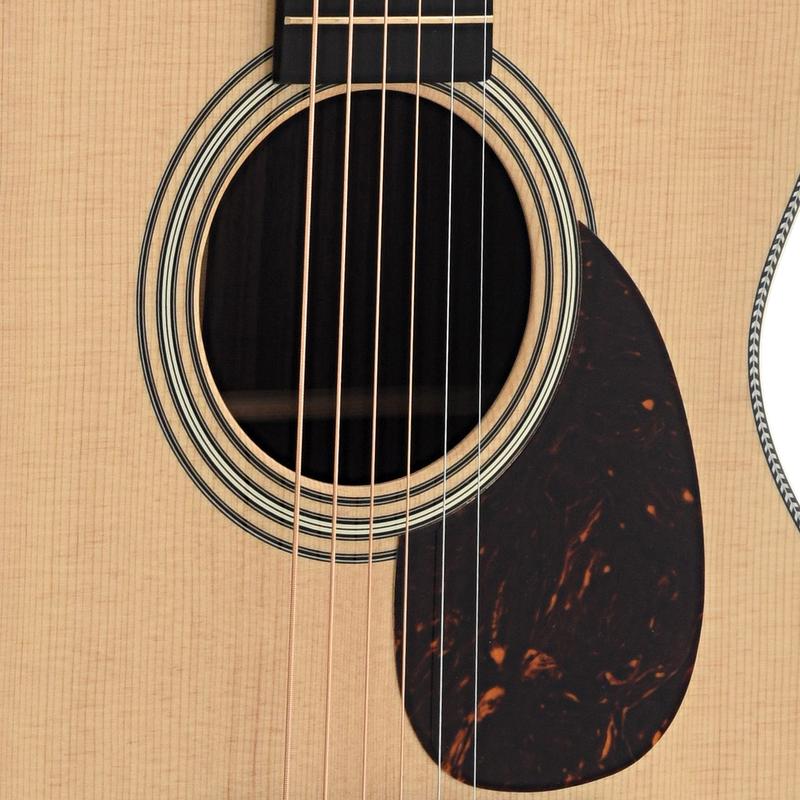The Light and Lovely Martin OM-28 Modern Deluxe is Both Modern and Deluxe
A lap piano for the discerning fingerstylist
Specs include: All solid wood construction; Indian rosewood back and sides; torrefied Sitka spruce top with scalloped, torrefied Adirondack spruce bracing attached with natural protein glue, carbon fiber/torrefied Adirondack spruce bridge plate; Genuine South American mahogany neck with Vintage Deluxe profile, satin finish, two-way adjustable titanium support rod, hand-fitted dovetail neck joint and solid mahogany neck block; ebony fretboard with Standard Taper, 1-3/4” width at nut, 2-1/4” at 12th fret, abalone Diamonds and Squares position markers, EVO Gold frets, solid bone nut; ebony bridge with Liquidmetal® bridge pins, compensated solid bone saddle and 2-1/4” string spacing; European flamed maple binding; bold herringbone purfling; high gloss nitrocellulose lacquer finish; high gloss Indian rosewood headstock faceplate with abalone script logo and golden Waverly open back tuners with butter bean knobs.
“The OM-28 Modern Deluxe loves to be lightly caressed and nimbly cajoled, so its steadfast notes and lighter-than-air harmonics launch and waft like the sumptuous aromas of intoxicating spirits. As with an elite sports car or a vintage OM of old, when it’s driven in the zone where the gears change friction-free, boy does it soar!”
OM as in Oh My Goodness!
The Martin OM-28 Modern Deluxe is a rosewood Orchestra Model, having an Auditorium-size body with a long-scale neck, made in a new upgraded version of Style 28 created for the Modern Deluxe Series that debuted in January, 2019.
What sets the OM-28 MD apart from the Standard Series OM-28 is the upscale appointments that include flamed maple binding, an abalone logo inlaid in the high gloss headstock, Waverly brand tuning machines, as well as golden EVO frets, and a series of technological advancements in acoustic engineering that give the entire Modern Deluxe Series a new kind of Martin sound. The details within that sound are unique to each Modern Deluxe model.
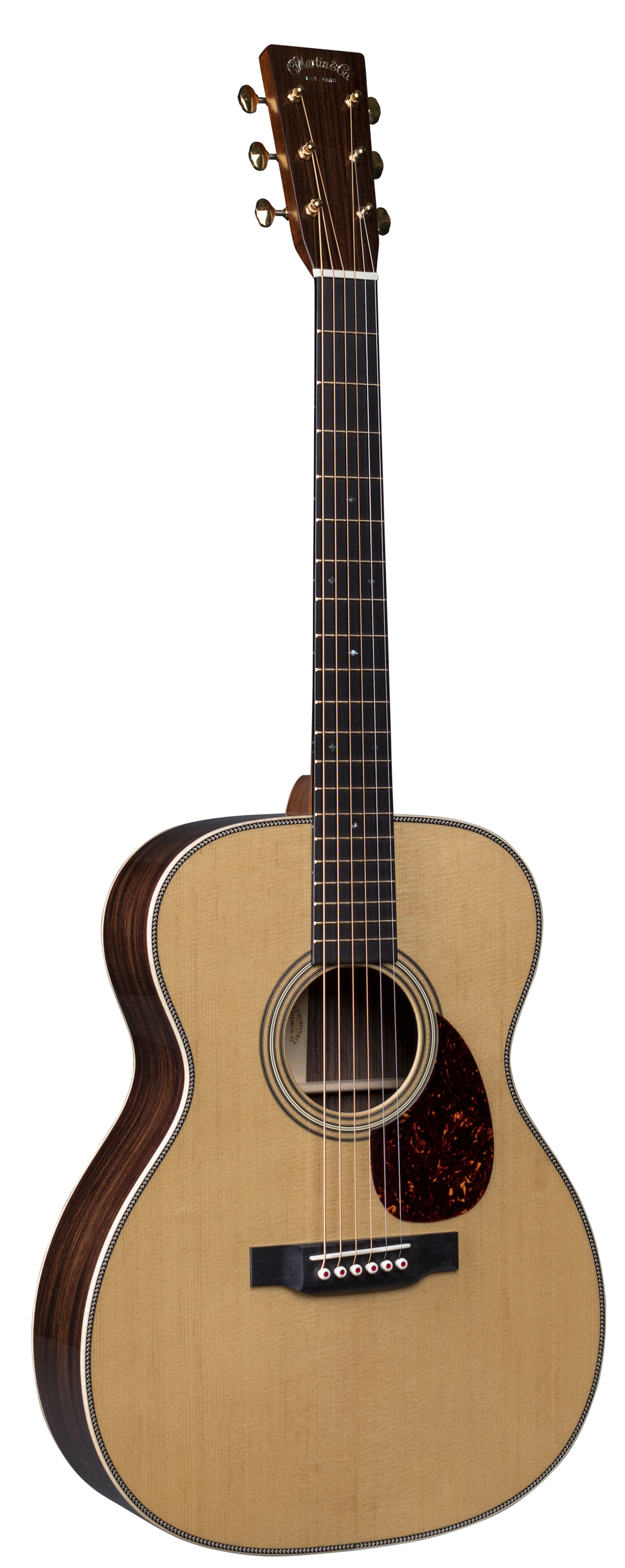 In classic orchestra model fashion, the voice of the OM-28 MD sets up a three-dimensional wooden frame and then fills up the interior with colorful, resonant tone that seems to expand in depth and width beyond what should be possible within the instrument’s actual physical dimensions. This cavernous inner space has a wide roof of six fundamental notes, shaped with precise definition, and ringing with immediacy, clarity, and steadfast sustain. And those sustaining fundamentals meld seamlessly with the harmonics they conjured out of thin air, the overtones pure as polished silver.
In classic orchestra model fashion, the voice of the OM-28 MD sets up a three-dimensional wooden frame and then fills up the interior with colorful, resonant tone that seems to expand in depth and width beyond what should be possible within the instrument’s actual physical dimensions. This cavernous inner space has a wide roof of six fundamental notes, shaped with precise definition, and ringing with immediacy, clarity, and steadfast sustain. And those sustaining fundamentals meld seamlessly with the harmonics they conjured out of thin air, the overtones pure as polished silver.
But the sonic presence that thickens up the undertone of a typical rosewood Martin is translucent here. That inner OM space is quite ethereal and lit up by the bright and gleaming high end chime more than from the warmth of the bassy cellar, which does not have the sort of murky shadows flooding the depths of most Indian rosewood guitars. The notes from the unwound treble strings are not as fat or powerful as those from other Martin OMs, and the mids and bass strings have a solid brassy impact that makes the guitar more of the lap piano variety, than the sort that brings to my mind a woody cello.
It is built to respond to the lightest picking, radiating tone from the least amount of effort. Conversely, it does not have the meaty roar of the Standard Series OMs. Rather, it has a dry bark when the strings are attacked with a flatpick or heavy claw hammer fingerpicking, and the voice compresses rather than explodes. But then, one needn’t tear into the OM-28 MD to force sound out of it. It practically plays itself. And when the guitarist plays within its zone of optimum resonance, it glows as if it had a radioactive core.
And you know what other guitars have dynamics and tone that could be described in much the same terms? Martin OMs from the early 1930s; that’s what.
While by no means identical in any of the various attributes mentioned above, the OM-28 Modern Deluxe played and responded more like a pre-war OM-28 than any OM ever built for Martin’s Standard Series, or the now retired Vintage Series, Marquis Series, or Golden Era Series. And glides up the e or b string, from one position to the next, can ignite a sympathetic overtone or unison from an open string that skyrockets in a way I have not heard from even the OM-28 Authentic 1931 – at least not to the same degree as I’ve heard coming from an OM-28 MD.
The singing ring, the effortless sustain, the reverberating wooden box sound from percussive slaps, the stark fundamentals during fast picking, and the expansive resonance during slow picking patterns. Vintage OMs all have that going on. The OM-28 Modern Deluxe has all that going on. But it is not the same ring, so it is not the same sound when sustaining. It is not nearly as reverberating a wooden box as a guitar made from 80 year-old rosewood, of course. Just as the specific sound of the notes and their echoing sympathetics are different even from other modern Martins. They are not the same, and yet alike in certain ways that other guitars are not.
So, the voice of the OM-28 MD is not that of a pre-war OM. And yet, it offers much that is reminiscent of those great old Martin OMs – more than I thought could possibly be found in a modern guitar with so much futuristic engineering fueling its tone-making apparatus. And therein is the irony of the Modern Deluxe Series:
That which makes these guitars feel and behave like vintage Martins is exactly the least traditional luthiery involved. And it is also what makes them have certain facets to their tonal personalities that remind me of vintage Martins, while at the same time producing tone unlike any other Martin made before them. In fact, it sets them apart tonally from any other acoustic guitars, for that matter.
click on photos to enlarge
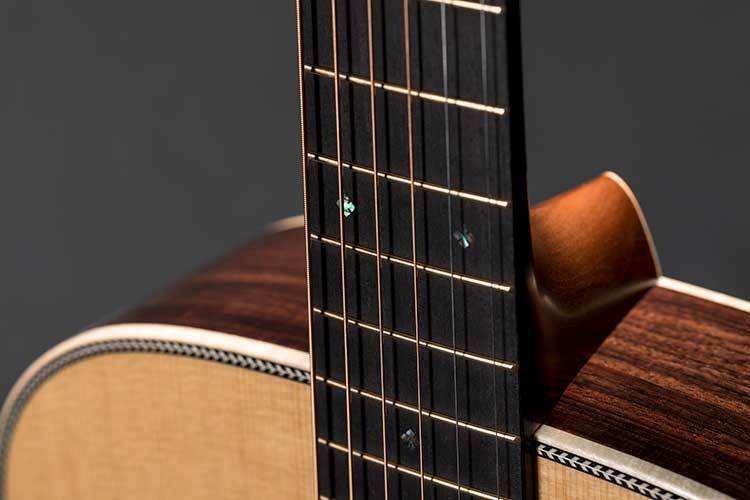 |
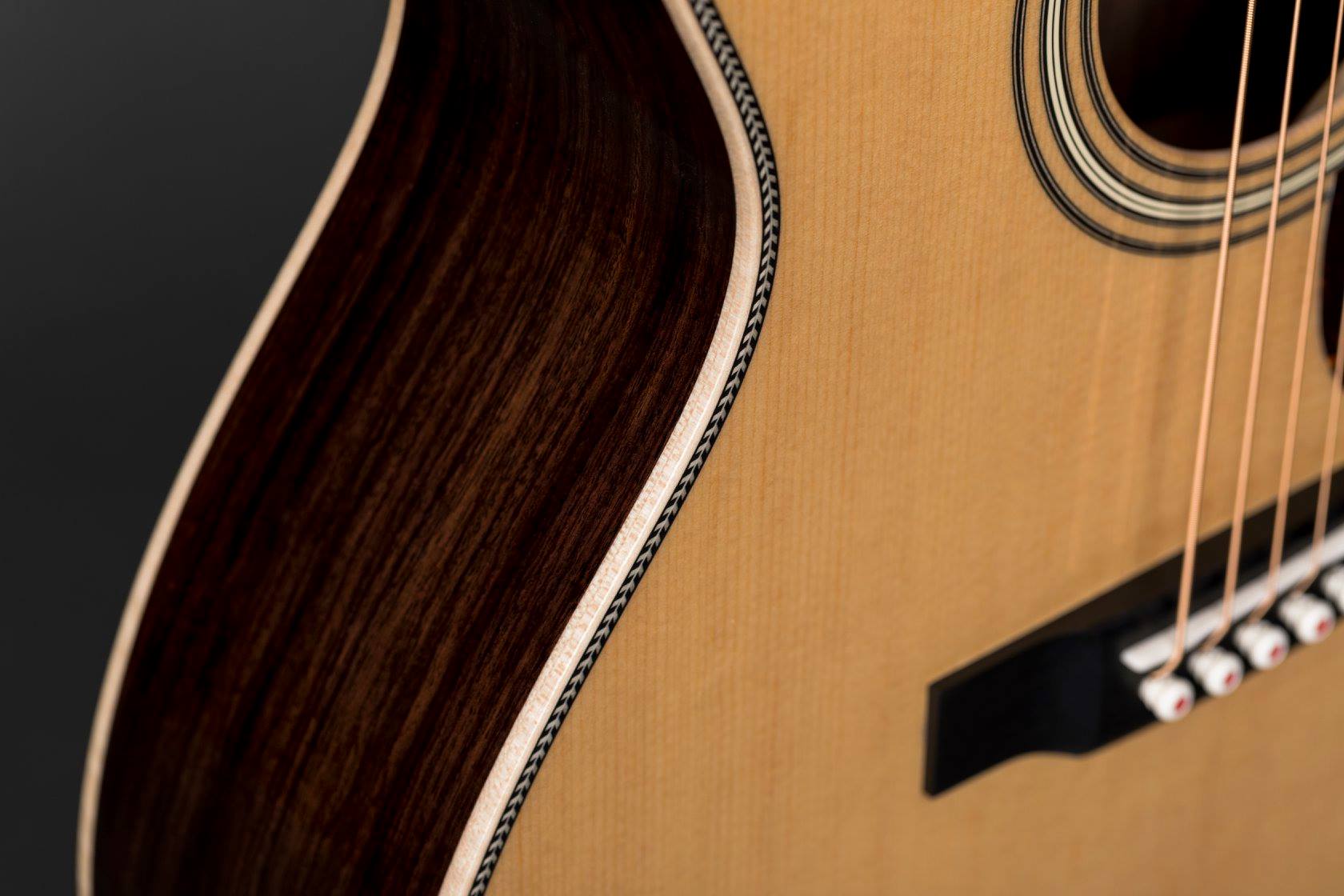 |
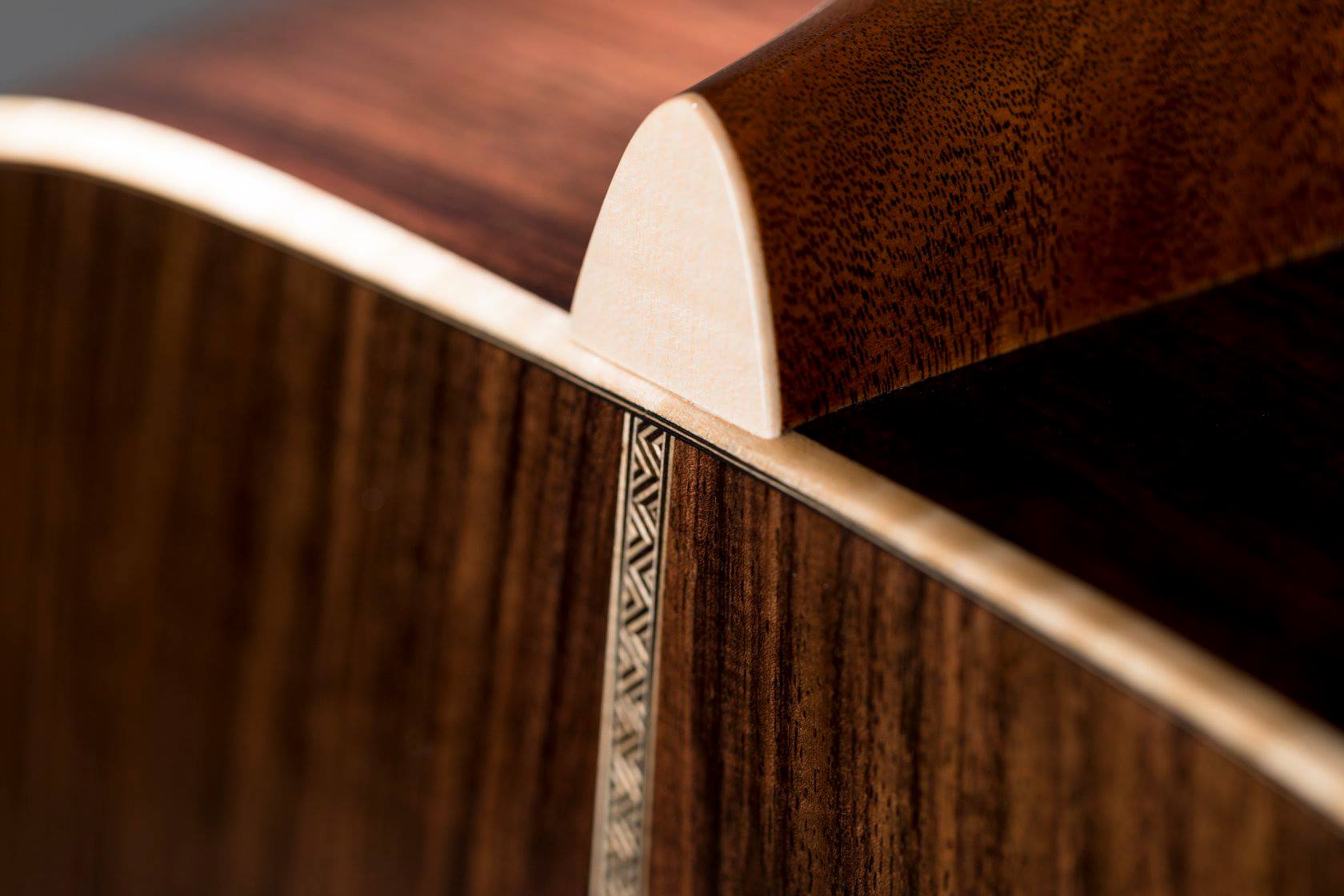 |
Vintage-esque Deluxe Neck
What sets this OM apart from the 000 and D size Modern Deluxe models is found in the width of its fretboard. They all have a nut width of 1-3/4”. But only the OM-28 MD has the Standard Taper, which is 2-1/4” at the 12th fret, matched with 2-1/4” string spacing. The others have the newer High Performance Taper, which is 2-1/8” at the 12th fret, matched with 2-5/32” string spacing. This changes the overall shape and feel of the neck, particularly in the upper frets.
This the first time Martin has released a guitar with the fretboard dimensions of a vintage OM since they converted the Standard Series to the High Performance Taper, along with almost all other non-Authentic Series instruments. The thinking behind this decision was that OMs have always attracted fingerstyle players, who often like wider string spacing. Since the Modern Deluxe Series is basically replacing the Vintage Series in the price range between the Standard Series and the Authentic Series, they are making the Modern Deluxe OMs with the taper of a vintage orchestra model, combined with the string spacing used on the old Standard Series OMs.
Also, the new Vintage Deluxe neck profile that debuted on the Modern Deluxe models was inspired by a singular neck shape taken from an actual pre-war OM. So they must have felt it appropriate for these new Orchestra Models to have a neck more like a traditional OM than the rest of the Modern Deluxe Series.
As mentioned over the years, I have declared that the particular neck on the Martin Museum’s priceless 1930 OM-45 Deluxe was the most comfortable vintage Martin guitar neck I have ever encountered. And I lobbied the powers that be to replicate it for other OMs, and not just the $60,000 Authentic Series model based on that fabulous old guitar. So, I was delighted when I heard they based the Vintage Deluxe Profile on that very neck.
When I got to the Martin factory to record my annual video footage, my first guitar was the OM-28 MD. I was forewarned that the neck was “inspired by” the old-timer, so I was not all that surprised to find how shallow the barrel was and how little V was to be felt along the apex of the neck. It wasn’t until I compared it directly to the vintage OM-45 DX that I realized it was much closer to the original article than I had guessed. I had not played the old guitar for over two years. It is likewise much shallower and with less of a V than I had remembered, and more so than most people would ever expect to find on a guitar from the 1930s.
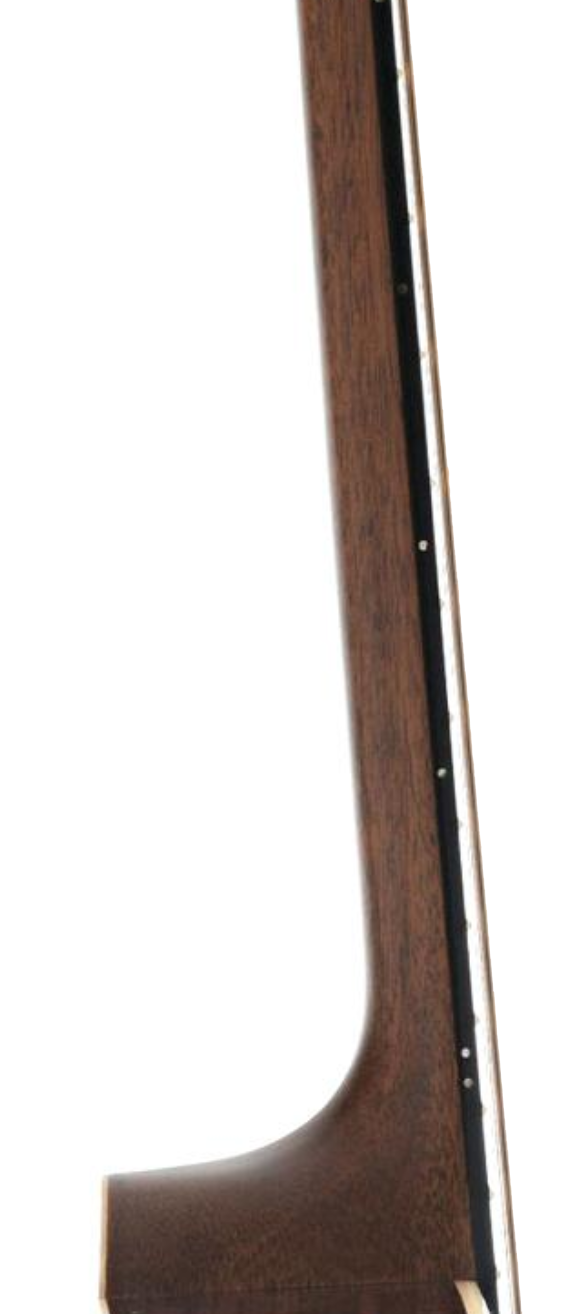 Not that the Vintage Deluxe Profile is a duplicate. The shape of the MD’s heel is modernized, so the neck stays relatively shallow all the way up to about the 12th fret, which allows the palm to remain parallel to the fingerboard father up the frets, like most acoustic guitars made today, which have necks more like electric guitars than not. But if I had to grasp each neck here and there between the third fret and, say, the eighth fret while wearing a blindfold, I am not sure I would be able to guess which was which. That is, until I focused on the string spacing, as it is a notably wider 2-3/8” on the 1930 OM.
Not that the Vintage Deluxe Profile is a duplicate. The shape of the MD’s heel is modernized, so the neck stays relatively shallow all the way up to about the 12th fret, which allows the palm to remain parallel to the fingerboard father up the frets, like most acoustic guitars made today, which have necks more like electric guitars than not. But if I had to grasp each neck here and there between the third fret and, say, the eighth fret while wearing a blindfold, I am not sure I would be able to guess which was which. That is, until I focused on the string spacing, as it is a notably wider 2-3/8” on the 1930 OM.
What is important here is how it feels in the hand. And that is happily similar to the vintage Martin. And the secret lies in how the neck is off-center rather than symmetrical. And the shaping of the bass side and treble side are subtly different – more subtle than on the old OM neck, but with the same effect.
And it is actually skewed, as Martin is calling it, so the shaping drifts as it advances from volute to heel. As I like to say, it seems to adjust to the changing shape of the hand as it moves up the frets, rather than expecting the hand to adjust to the neck. It just feels effortlessly comfortable no matter where I am holding it. You can follow the link below to learn more about the direct comparison between the OM-28 Modern Deluxe and the 1930 OM-45 Deluxe.
Something else this new OM has in common with the old one is how it feels in terms of balance. The Genuine Mahogany neck is much lighter in weight than typical for a modern-day Martin. This lightens up the overall weight of the guitar, but also changes the weight ratio between neck and body. It simply feels more like an old Martin than a new one.
When I first strummed it, I was startled by how much the neck vibrates in the hand. Again, in this respect it was more like a pre-war Martin than a modern Martin. It is a feature shared by all of the Modern Deluxe Models, by the way. And it is because their solid ebony fingerboards have a vintage Martin thickness, which is thinner than modern Martins, and they all have a titanium support rod hidden underneath it.
This neck rod is one of the futuristic features that have been tried out at Martin in recent years and brought together in the Modern Deluxe Series. It is essentially their two-way adjustable rod invented by Martin’s Leslie Mammele some years back, but it is made with a titanium alloy that reduces weight compared to a steel rod, without compromising strength or rigidity.
This extra vibration in the solid mahogany neck and thin fretboard allows more string energy to contribute to tone production as it is transferred to the body through the hand-fitted dovetail neck joint and solid mahogany neck block. This is but one example of Modern Deluxe technology melding with traditional Martin guitarmaking to reap some very good results.
High Tech Teamwork
The Liquidmetal bridge pins work together with a composite bridge plate, made from carbon fiber and torrefied Adirondack spruce, to increase sustain and volume by allowing more of the physical energy from the vibrating strings to be injected into the spruce soundboard. And the scalloped braces are glued to the top with fish-based natural protein glue akin to the old-fashion hide glue used on vintage Martins, for a superior bond and maximized energy transference. All this cutting-edge engineering helps to create an abnormally responsive instrument with impressive sustain – characteristics for which vintage Martins are coveted.
The carbon fiber bridge plate and Liquidmetal bridge pins also work together to help create the more atypical, non-vintage aspects of the signature Modern Deluxe tone, like the brilliance of the high-end chime, crisply defined wound strings, and a significant increase in the initial sustain of the fundamental notes that serves to accentuate the tonal brilliance all the more.
I remain unsure if the bridge plate and bridge pins are the source of the remarkable brilliance and definition, or if they are simply increasing their sustain. And perhaps that fundamental sustain seems louder, without there being an actual increase in volume. But one bit of technology that definitely contributes to an increased tonal chime, and a sense of an open and freely expressive voice, is the propriety torrefaction treatment applied to the Sitka spruce soundboard and the braces, which Martin calls their Vintage Tone System.
Torrefied wood has been baked in a special kiln until the inherent moisture has been removed and the cellular interiors crystallize. At that point, it takes on the physical properties similar to wood that had seasoned naturally for many decades. And in some ways it makes the tone sound more like that too, as a new top does not sound so tight or like the tone is trapped inside waiting to get out. Instead, the body resonance reflecting the main notes and humming around them is intensified and livelier, and there is a greater sense of three-dimensional depth to the voice in general.
Read more about wood torrefaction and Martin’s VTS HERE.
Braced for Responsiveness
The bracing on the Modern Deluxe models is made from Adirondack spruce, which has not been used in combination with a Sitka spruce top on a regular Martin model before now. And they are scalloped in the Golden Era style, which removes more mass with more extreme angles to the carving than standard scalloping. It is as close to pre-war scalloping as Martin offers outside of the Authentic Series. But these braces are made from spruce that was torrefied by the Vintage Tone System, which is one thing they did allow to come down from the Authentic Series on high.
Adirondack spruce is stiffer than Sitka, and the GE bracing makes it more flexible. But it is not like those two things cancel each other out or like there are six of one half dozen of the other. And then there is the torrefaction, which allows the braces to transmit tone-producing physical energy more easily, just like the special glue used to attach them to the torrefied soundboard. So the overall physics of the Modern Deluxe bracing is unprecedented, and as with the other technology involved, it is impossible quantify its specific contribution to the unique voice. All in all, it the culmination of a lot of little parts making up a sophisticated machine, designed and built to produce and broadcast as much tone as possible from a guitar as responsive to nuanced playing as possible.
There are many guitars made with VTS spruce tops. None of them sound like a Modern Deluxe model. All of the individual components, both traditional and innovative, play a part in why the OM-28 MD feels, sounds, and plays as it does, and is as vintage-like as it isn’t. Yes, there is irony and a sense of cross purposes in this guitarmaking recipe. And yet the finished dish is de-lish.
The Long and the Short of It
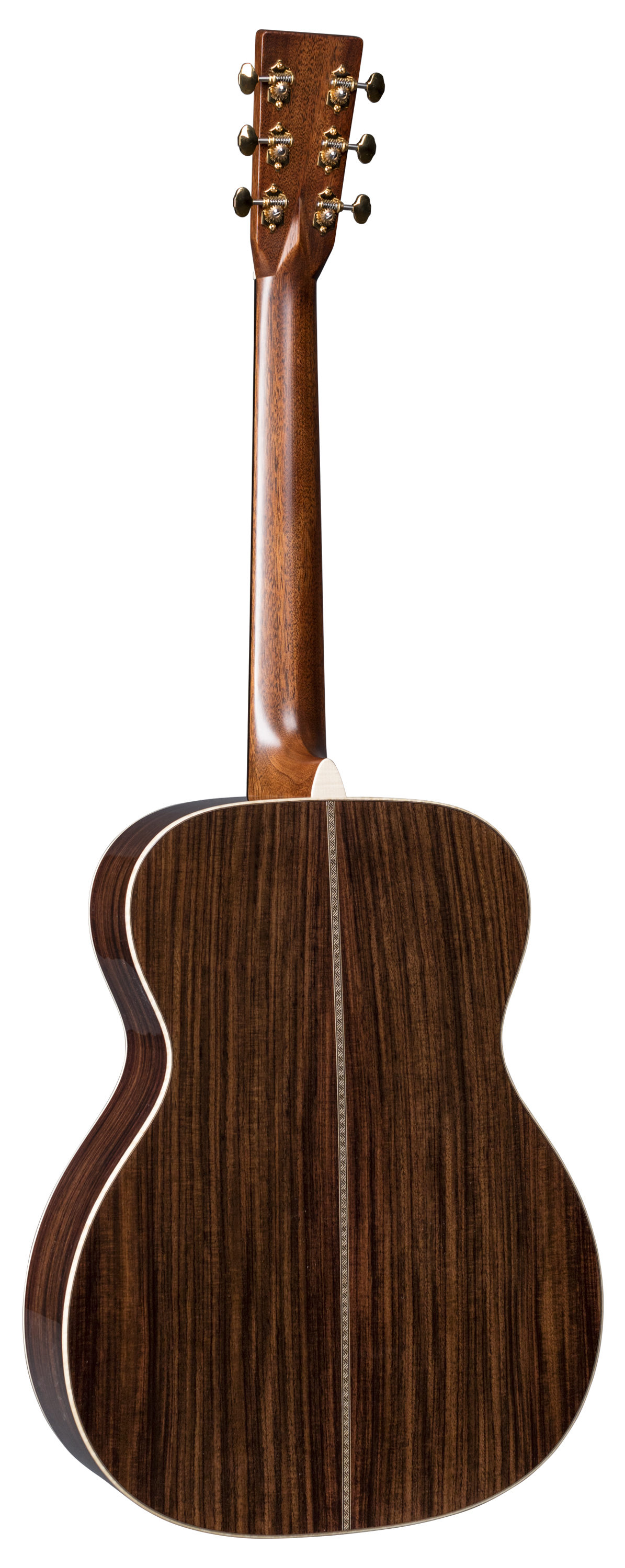 I have chosen to publish the reviews of the OM-28 MD and the 000-28 MD simultaneously, since they are so close in design and construction. If you would like more details about the various Modern Deluxe appointments and the acoustic engineering elements, please refer to the 000-28 MD review HERE.
I have chosen to publish the reviews of the OM-28 MD and the 000-28 MD simultaneously, since they are so close in design and construction. If you would like more details about the various Modern Deluxe appointments and the acoustic engineering elements, please refer to the 000-28 MD review HERE.
I am using the space saved by not going into such detail twice, to remark upon a direct comparison between these two related models.
The OM-28 MD has the same body dimensions as the 000-28 MD, which Martin refers to as their Auditorium size. What makes them different models is the string scale – the length of the playable string from the bone nut at the end of the fretboard to the bone saddle in the bridge.
The scale on the OMs is 25.4 inches (actually 25.340”.) Called the “long scale,” it is used on the Dreadnought, Grand Performance, M (0000,) Jumbo, and Grand Jumbo sizes.
The scale on a traditional 000 is 24.9 inches (actually 24.840”.) Called the “short scale,” it is used on guitars made in their 00 Grand Concert size, 0 Concert Size, and the traditional 000s (so called because Martin has made some 000s with long-scale necks in Style 16 and below since the 1990s, because it had become the industry standard.) In both cases the string scale is a bit longer than the 25” and 24-7/8” used for vintage Martins.
The reason both designs are close yet different comes from the Martin 000 evolving out of the original Orchestra Models, the first 14-fret flattop acoustic guitar. It was invented in 1929 but ceased to exist by 1934, when it became the 000 before having its string scale shortened. Martin resurrected the long-scale OM decades later. So, the two related designs now exist simultaneously.
You can read more about the evolution and spec changes to the 000 and OM designs HERE.
To the unfamiliar eye the OM-28 MD and the 000-28 MD look exactly the same, but for the shape of the pickguard. That is because the first OMs built in 1929 and 1930 had a smaller guard, and today’s OMs sport something like it to make them easier to tell apart from 000s.
Martin 000s had 5/16” braces since the 1930s, with the exception of the current 000-18 and some retired 000s from the Marques, GE, and Authentic Series, which have 1/4″ OM bracing to help create a more vintage-like responsiveness. And the 000-28 Modern Deluxe likewise has the same 1/4″ bracing of its OM counterpart. However, there are slight differences in the exact placement of the X brace and surrounding tone bars due to the different string scales.
To refresh my memory before writing this review, I visited Sam Ash’s flagship store in Manhattan, where I spent two hours with an OM-28 MD and a 000-28 MD, that were fresh from their shipping boxes. Both guitars might seem nearly alike compared to a dreadnought or guitars from some other manufacturer. But for being so close in design and materials, they have significant differences in tone and dynamics.
The extra string tension from the long scale puts more stress on the bridge, and injects more energy into the Auditorium-size top. In the case of the OM-28 MD, it has increased depth and greater bass response compared to the 000-28 MD. The notes seem more spread out and the body resonance has more of an echo effect, and it is a bigger part of the overall sound. The 000 has a more gathered, punchy voice with a simpler, reflective undertone that puts the focus very much on the fundamental notes and high harmonics.
I have been an OM man basically since I started playing Martins. I like the extra resonance, the wider spread of the fundamentals, with the rounder bottom bass throb on the one side and the fatter note to the high e string at the other, and a bigger voice overall. But I have actually converted to the short scale in recent years, because my aging sports injuries like having the frets a little closer together. And having a little less tension in the strings is less fatiguing, while making lead guitar bends much easier to achieve.
Yet still my ears love the OM sound best of all. The way the tone bubble expands in all directions to engulf the player just makes me feel absorbed into the voice of the guitar. And the echoing, wavering Martin undertone is nowhere more alive and alluring than within the heart of an OM.
The traditional short-scale 000 is a different kind of experience. It is more intimate for the player and more about the individual notes than the sympathetic resonance, which takes a back seat to those driving fundamentals. And the 000-28 MD’s voice has all the hallmarks of a typical Martin 000. Both models are worthy instruments. But I think the OM-28 MD trumps the 000 when it comes to the tone. Others may feel the opposite.
But I will add, liking the OM voice better or no, the narrower fretboard on the 000-28 MD may be a deciding factor for players who do not have long thumbs and fingers, but want to do a lot of thumb-fretting, or those who can make good use of less stressful stretches, as well as string bends that achieve notes that a long-scale guitar cannot reach.
A Bold New Traditional OM
 The majority of the specs within the Modern Deluxe Series are contemporary in nature, adorning a Martin guitar with deluxe features usually seen in exclusive boutique luthiery or high-priced limited edition Martins. Aside from the species of the tonewoods, just about every individual part of a Standard Series Martin has received an upgrade. They have taken the mystique of vintage Martin aesthetics and modernized them to create a new mystique. But the neck has been shaped to feel very much like an actual vintage Martin. And the OM-28 Modern Deluxe feels more like that very special old Martin than the rest.
The majority of the specs within the Modern Deluxe Series are contemporary in nature, adorning a Martin guitar with deluxe features usually seen in exclusive boutique luthiery or high-priced limited edition Martins. Aside from the species of the tonewoods, just about every individual part of a Standard Series Martin has received an upgrade. They have taken the mystique of vintage Martin aesthetics and modernized them to create a new mystique. But the neck has been shaped to feel very much like an actual vintage Martin. And the OM-28 Modern Deluxe feels more like that very special old Martin than the rest.
And then there is all that unusual engineering that manages to make a Space Age Martin that feels and produces tone more like a Martin made in the Jazz Age, even if the actual sound might be better described as an alternate universe version of pre-war Martin tone. Maybe even something that came out of the replicator on Captain Kirk’s starship, for that matter.
All in all, the Modern Deluxe sound is something unto itself. And the OM-28 MD stands apart from the rest, because of its neck width, and because it is the only OM in the Series (thus far.) There will be people who prefer the Standard OM-28, for any number of reasons. There will be those who prefer the 000-28 Modern Deluxe as well. But there will be many who are seduced by the particular voice of the OM-28 MD, and the sensual appeal of its neck, and the way it responds to subtlety and nuanced playing, so much so that guitar shops will have a hard time keeping them in stock.
My only qualm is that they are setting up these guitars with strings way too low for a serious guitarist. They are at extreme tolerances for the “super low action” that amateurs who learned on electric guitars believe to be a sign of a good guitar.
The prototype I played at the factory in January had sat out in the lobby all of 30 minutes when we brought it back to the sound room. It was enough of a change in humidity that the relief changed, and I could barely play it up the neck without it sounding like a sitar. That is obvious in the video I shot, where I was playing it as lightly as I possibly could. The one at Sam Ash was only slightly better. But it did force me to play with delicacy, which revealed just how much pretty tone rings out of it at such low levels of (non) attack.
I would love to see one of these OMs with the action set about mid-way in the official Martin specs for string height, so I could really dig in and inject my emotional power into the soundboard to see how it responded. Maybe even try medium-gauge strings on it. Ah well.
Action is easily adjusted to suit the needs of a particular owner. And this OM really isn’t at its best under a heavy hand anyway. I think the guitarists who will love this model most are the ones who want the most tone for the least amount of effort. The OM-28 Modern Deluxe loves to be lightly caressed and nimbly cajoled, so its steadfast notes and lighter-than-air harmonics launch and waft like the sumptuous aromas of intoxicating spirits. As with an elite sports car or a vintage OM of old, when it’s driven in the zone where the gears change friction-free, boy does it soar!
And that is one man’s word on…
The Martin OM-28 Modern Deluxe
List Price $5,199.00 – Ask your Martin dealer for their best price!
More Photos Here
Related Reading:
Vintage Deluxe Neck Compared to Actual Vintage Martin
Martin 000-28 Modern Deluxe Review
Martin D-18 Modern Deluxe Review
Martin D-28 Modern Deluxe Review
Martin 000 vs OM, What’s the Difference?
Martin Announces the Modern Deluxe Series
Torrefication (Torrefaction) and Its Use in Luthiery
Official Martin OM-28 Modern Deluxe Spec Sheet
